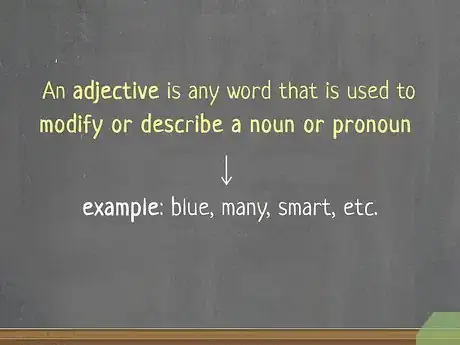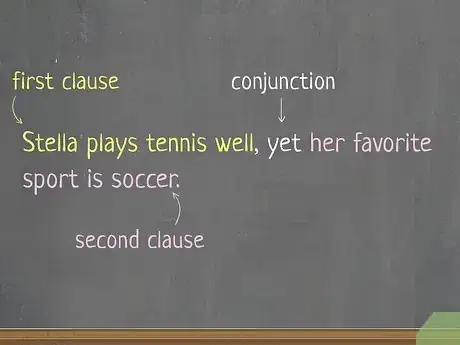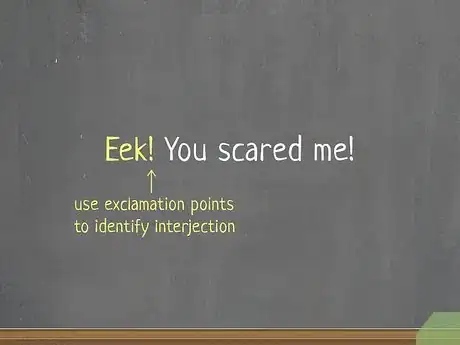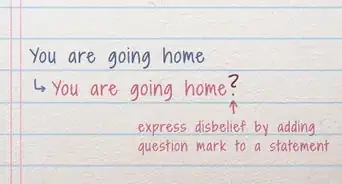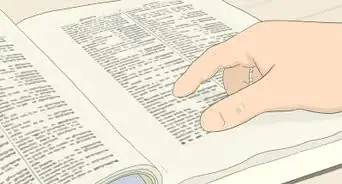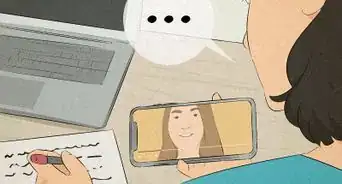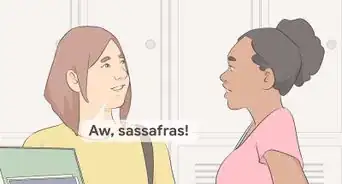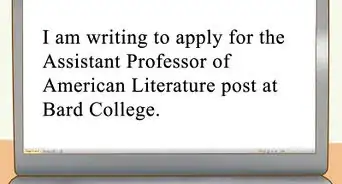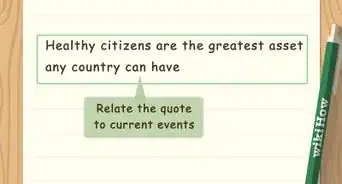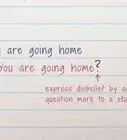This article was co-authored by Alexander Peterman, MA. Alexander Peterman is a Private Tutor in Florida. He received his MA in Education from the University of Florida in 2017.
There are 10 references cited in this article, which can be found at the bottom of the page.
wikiHow marks an article as reader-approved once it receives enough positive feedback. This article received 18 testimonials and 100% of readers who voted found it helpful, earning it our reader-approved status.
This article has been viewed 336,198 times.
Parts of speech are categories that are used to describe each word's function in a sentence. The best way to identify a word's part of speech is to think about what role the word plays in the sentence, but there are also a few clues that can help you figure out the part of speech if you are unsure about the word's function.
Steps
Analyzing the Word's Function
-
1Identify naming words as nouns. A noun is any word that names a person, place, thing, or idea. Nouns can be concrete (Alice, dog, table, etc.) or abstract (beauty, independence, cycle, etc.).[1]
- Proper nouns are used to name a specific person, place, or thing, and the main words are always capitalized (Fred, New York, the Declaration of Independence).
- Nouns can be either singular or plural.
- Nouns can be possessive, in which case they typically end in 's or s'.
-
2Know that pronouns stand in for nouns. Sometimes, a noun is not always named. Words that do not directly name a person, place, thing, or idea, but take the place of a word that does, are pronouns.[2]
- Some pronouns stand in for people's names (he, our, they, hers, etc.).
- Other pronouns represent an object or idea (it, these, this, etc.).
- Pronouns may also stand in for very indefinite nouns that may be difficult to name without the use of a pronoun (everyone, no one, something, etc).
Advertisement -
3Recognize action words as verbs. A verb is any word that is used to express an action (run, cleaned, driven, etc) or being (is, was, been, etc). Verbs have multiple tenses that express when the action took place.[3]
- Auxiliary verbs (also known as helping verbs) are words that are used to change the tense of the main verb (will, did, would, etc.). These are still considered verbs.
-
4Learn that adjectives modify nouns and pronouns. An adjective is any word that is used to modify or describe a noun or pronoun (blue, many, smart, etc.). Adjectives typically answer questions like "how many?", "what kind?", or "which one?"[4]
- Numbers are considered adjectives when they are used to answer the question "how many?"
- Articles (a, an, and the) are considered adjectives by many because they answer the question "which one?" However, some people consider articles to be a separate part of speech.
-
5Know that adjective and verb modifiers are adverbs. An adverb is similar to an adjective in that it is used to describe or modify. Instead of modifying a noun or pronoun, however, an adverb modifies a verb or adjective (happily, extremely, then, etc.). Adverbs typically answer the question "how?", "why", "when?", or "how much?"[5]
- Adverbs may also modify other adverbs. (I ran very quickly.)
-
6Understand that prepositions express relationships. A preposition is a word or phrase that is used to show the relationship between noun or pronoun and another element in the sentence (at, by, in, to, from, with, etc.). Prepositions are typically very short words.[6]
-
7Identify words used to join clauses as conjunctions. A conjunction is a word that connects other words, phrases, or clauses (and, but, or, because, etc).[7]
- Coordinating conjunctions are used to join two clauses that are equally important to the sentence. There are 7 coordinating conjunctions: and, but, for, nor, or, so, and yet. (I like cats, but I don't like dogs.)
- Subordinating conjunctions are used to join a main clause and a subordinate clause, which is less important to the sentence. (I went outside, although it was raining.)
-
8Recognize exclamations as interjections. An interjection is a word or phrase used to express an emotion or feeling, such as surprise. (oh, wow, my goodness, etc). Interjections are capable of standing alone and are not grammatically related to the rest of the sentence. However, they can also be included in a sentence, separated by parenthesis, dashes, or comas on either side of the interjection.[8]
Using Word Placement and Punctuation Clues
-
1Learn the Subject-Verb-Object rule. Most sentences in the English language have the same basic structure: the sentence begins with the subject, followed by the verb, and then the object (if the sentence has an object). There are exceptions to this rule, but understanding the norm can help you identify the parts of speech in most sentences.[9]
- Both the subject and object of a sentence will contain a noun or pronoun. This means that a sentence that has both a subject and an object will contain a noun or pronoun both before and after the verb. (I ate the apple.)
- The subject and object may contain modifiers such as adjectives as well.
- When the sentence has a direct object, it will come directly after the verb. (I like cookies.) When the sentence has an indirect object, it will come after a preposition. (I gave the card to Frank.)
-
2Understand correct adjective and adverb placement. Although there are certainly exceptions to the rules, the placement of adjectives and adverbs is usually very predictable. Understanding where these words are most often found can help you identify them in sentences.
- Adjectives are almost always found before nouns and pronouns (We look at a red dress.) or after the linking verb "to be" (The dress is red.)[10]
- When adverbs are used to modify adjectives, they are almost always found right before the adjective. (The meal was truly delicious.)[11]
- When adverbs are used to modify verbs, they may be found before the subject (Later I will walk to school.), directly before the verb (I will carefully clean the artifacts .), or directly after the verb. (I go to the park frequently.)
-
3Identify clauses and phrases to find conjunctions. Because conjunctions are typically found between two clauses or phrases, you should be able to identify one by looking for the clauses or phrases that it joins together. If the word comes between the two clauses or phrases and seems to join them, it is likely a conjunction.
- Conjunctions like "and" and "but" are sometimes used at the beginning of a sentence, although this is more rare. When it is done, you should be able to identify the other clause or phrase in the previous sentence.
-
4Use exclamation points to identify interjections. Some interjection are followed by exclamation points because they express emotional responses.[12] If you see an exclamation point, the word proceeding it may be an interjection, although exclamation points are used after other types of words as well.
- Not all interjections are marked by exclamation points. Don't rely on exclamations as the only way to recognize interjections.
- Another clue that a word might be an interjection is that it is used alone. If there are other words in the sentence, it is less likely to be an interjection.
-
5Look for nouns and pronouns to identify prepositions. Prepositions are typically found before noun or pronoun phrases. (I went to the store.) This is because the preposition expresses the relationship of the noun or the pronoun to the previous part of the sentence.
- Keep in mind there may be an adjective, adverb, and/or article between the preposition and the noun or pronoun. These modifiers are all considered to be part of the noun or pronoun phrase. (We paid for the very expensive jeans.)
Using Suffix Clues to Identify Parts of Speech
-
1Recognize suffixes that are common in nouns. Although not all nouns contain one of these suffixes, many do. Understanding that they are most common in nouns can help you identify the part of speech of a word, even if you do not know its meaning. Look for the following suffixes to help identify nouns:[13]
- -ion (population)
- -sion (tension)
- -tion (attention)
- -acy (accuracy)
- -age (image)
- -ance (allegiance)
- -ence (permanence)
- -hood (childhood)
- -ar (scholar)
- -or (editor)
- -ism (idealism)
- -ist (realist)
- -ment (government)
- -ness (sadness)
- -y (beauty)
- -ity (capacity)
-
2Know which suffixes are common in adjectives. Just as with nouns, there are certain suffixes that are most commonly used with adjectives (although there are exceptions). Committing the following suffixes to memory may help you identify adjectives in sentences more easily:[14]
- -al (clerical)
- -ful (wonderful)
- -ly (friendly)
- -ic (chronic)
- -ish (squeamish)
- -like (childlike)
- -ous (contagious)
- -y (yappy)
- -ate accurate
- -able (laughable)
- -ible (horrible)
-
3Learn which suffixes are common in verbs. There are a few suffixes that are used with verbs more often than any other type of word. If you see one of the following suffixes on a word, it is likely that it is a verb:[15]
- -ify (typify)
- -ate (proliferate)
- -ize (rationalize)
- -en (tighten)
-
4Remember that most adverbs share a common suffix. Adverbs are by far the easiest parts of speech to identify using suffix clues. This is because the majority of adverbs end in the suffix -ly (merrily, wonderfully, quickly, etc.). If you see a word that ends in this suffix, there is a very good chance that it is an adverb.[16]
- There are some words that end in -ly that are not adverbs (butterfly), so be careful not to overgeneralize.
- There are also a few adverbs that do not end in -ly (well, fast, very, etc.).
Practice Questions and Answers
Community Q&A
-
QuestionWhat part of speech is the word "has"?
 Community Answer"Has" is a verb because it expresses an action. Depending on the sentence it is used in, it may be a main verb (He has the flu) or an auxiliary verb (She has traveled to Spain), but either way, it is still a verb.
Community Answer"Has" is a verb because it expresses an action. Depending on the sentence it is used in, it may be a main verb (He has the flu) or an auxiliary verb (She has traveled to Spain), but either way, it is still a verb. -
QuestionWhat part of speech is an article?
 Community AnswerArticles (a, an, and the) are considered by some to be adjectives because they modify nouns. Other people consider articles to be a completely separate part of speech.
Community AnswerArticles (a, an, and the) are considered by some to be adjectives because they modify nouns. Other people consider articles to be a completely separate part of speech. -
QuestionIn the sentence "Spring flowers are very beautiful" what part of speech is "spring"?
 Community Answer"Spring" is an adjective because it modifies the noun "flowers."
Community Answer"Spring" is an adjective because it modifies the noun "flowers."
References
- ↑ https://www.englishclub.com/grammar/noun-what.htm
- ↑ https://www.scribbr.com/nouns-and-pronouns/pronouns/
- ↑ https://www.butte.edu/departments/cas/tipsheets/grammar/parts_of_speech.html
- ↑ https://www.butte.edu/departments/cas/tipsheets/grammar/parts_of_speech.html
- ↑ https://www.butte.edu/departments/cas/tipsheets/grammar/parts_of_speech.html
- ↑ https://academicguides.waldenu.edu/writingcenter/grammar/prepositions
- ↑ https://www.scribbr.com/language-rules/conjunctions/
- ↑ https://www.butte.edu/departments/cas/tipsheets/grammar/parts_of_speech.html
- ↑ https://gsalearningsupport.com/skills-for-study/communicating-your-learning/communicating-clearly-in-writing/clear-sentence-construction/clear-sentences-use-correct-grammar/subject-verb-and-object/
- ↑ http://grammarist.com/grammar/adjectives/
- ↑ https://www.englishclub.com/grammar/adverb-position.htm
- ↑ https://www.gingersoftware.com/content/grammar-rules/exclamation-mark/
- ↑ http://www.southcentral.edu/images/departments/ASC/documents/Suffixes_that_Indicate_Part_of_Speech_2.pdf
- ↑ http://www.southcentral.edu/images/departments/ASC/documents/Suffixes_that_Indicate_Part_of_Speech_2.pdf
- ↑ http://www.southcentral.edu/images/departments/ASC/documents/Suffixes_that_Indicate_Part_of_Speech_2.pdf
- ↑ http://www.southcentral.edu/images/departments/ASC/documents/Suffixes_that_Indicate_Part_of_Speech_2.pdf
About This Article
To identify different parts of speech, analyze the function that the word plays in a sentence. If the word names a person, place, thing, or idea, it is a noun. Label a word as a pronoun if it takes the place of a noun. If you see a word that expresses an action, that is a verb, and words that modify a verb are adverbs. If a word modifies a noun or pronoun, it is an adjective. To learn how to identify prepositions, conjunctions, and interjections, read on!



